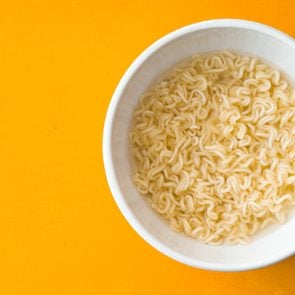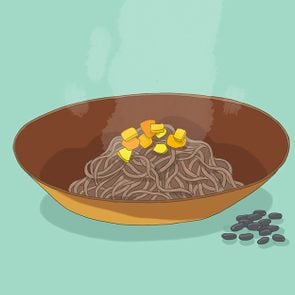A Vegan Ramen Recipe This Nutritionist Loves
Updated: Feb. 24, 2023
A registered dietitian shares her go-to vegan ramen recipe you'll want to eat every day.
Our editors and experts handpick every product we feature. We may earn a commission from your purchases.
Is vegan ramen healthy?
This is a bit of a loaded question. And we definitely need some context to answer whether or not ramen is healthy. If we’re talking about the 30-cent ramen meals that come in a plastic bag with a sketchy packet of “seasoning,” then the answer is no. That ramen has simple carbs, not enough protein, and about 70 percent of the daily recommended amount of sodium. No, thank you. (Here’s what happens if you eat ramen every day for a week.)
Don’t fret, though: There is such a thing as healthy ramen. In fact, homemade ramen has all the potential in the world to be a healthy and balanced meal. Plus, with just a few changes, you can easily make vegan ramen. You just have to be picky about the type of noodles, include a source of protein, and add all the veggies you like.
Origins of ramen
Ramen has taken quite the journey over the years. What began as a widely consumed meal in Asian culture due to its low price and reliable shelf life soon became a notorious staple in American college students’ diets. Today, ramen is a popular delicacy with immense popularity in restaurants throughout the food world.
The roots of ramen bring us back to 17th century China. The noodles, a healthy alternative to pasta, went by “Chinese soba” noodles up until the 1950s. When Chinese populations settled in the Yokohama, Kobe, and Nagasaki ports, they formed Chinatown. The area was populated with poor, working-class families in need of cheap, yet satiating sustenance. Enter ramen.

Health benefits of ramen
OK, remember how I said homemade ramen could actually be quite healthy? Let’s talk about how. Essentially, ramen consists of noodles in broth, with whatever add-ins you desire. First, let’s talk about the noodles.
Noodles
The noodles that come in the cheap, packaged ramen soups are processed white noodles. One of the main ingredients is enriched wheat flour, which is wheat flour stripped of its fiber and nutrients. When making vegan ramen at home, the noodles are an opportunity to add some healthy nutrients. I suggest going with whole wheat or brown rice for vegan ramen noodles. This will increase the fiber content. It will also make the carbs from those noodles slower digesting. (If you’re opting for store-bought, a great vegan option we love with wheat flour untouched by bleaching agents is KinjBang Noodles!)
Broth
When it comes to the broth, I would suggest using a plain, low-sodium vegetable broth. This will add some flavor without overloading the sodium content of the soup. (Here are the most common high-sodium foods.)
Add-ins
Add-ins are your chance to really bump up the nutritional value of ramen soup. And the best way to do this is by adding all the veggies. Add any and all non-starchy veggies you like, such as broccoli, scallions, peppers, onions, zucchini, cauliflower, eggplant, carrots, cabbage, celery—the list goes on. By doing this, you’re adding tons of fiber and micronutrients without a ton of calories.
Finally, you’ve got to have a source of protein. For my vegetarians and vegans, tofu and tempeh are your friends. I suggest sautéing some tofu or tempeh in a bit of avocado oil—that will get the outside nice and crispy—and then add it to the soup. This will add protein and textural contrast to the rest of the meal. (Here are the best vegan protein sources.)
For the omnivores out there, try adding chicken, lean beef, salmon, shrimp, or eggs. These are all lean sources of animal protein that would make great additions to a hot bowl of ramen.
What’s the deal with vegan ramen?
There actually isn’t a huge difference between vegan and non-vegan ramen. The main differences are the choice of broth and the protein addition. Typical ramen has chicken, or beef broth and animal proteins. In vegan ramen, you just use a vegetable broth and skip the animal-based protein. You can opt for a plant-based protein, or skip the protein addition altogether. The dietitian in me, however, urges you not to skip protein.
How to make vegan ramen
Alright, now for the fun part: my favorite vegan ramen recipe. This is easy and customizable. You can switch up the veggies to include your favorites. My favorite part is that you can make vegan ramen with ingredients most people already have. You can use fresh or frozen veggies, any noodles you have, and any protein source you prefer. It’s a great go-to recipe for when you want a quick, easy, and healthy meal.
Vegan Ramen
Serves two
Ingredients:
2 tablespoons avocado oil
2 cloves garlic, minced
2 teaspoons ginger, minced
1/2 cup white button mushrooms, sliced
1/2 cup broccoli, cut into ½-inch florets
1/2 cup zucchini, sliced
1/4 cup green onions, chopped
1 tablespoon low-sodium soy sauce or coconut aminos
Pinch red pepper flakes
4 cups low-sodium vegetable broth
6 oz whole wheat ramen noodles
2 tablespoons cilantro, chopped
Instructions:
Add avocado oil to a medium-sized pot over medium-low heat. Stir in garlic and ginger, and sauté until fragrant (about two minutes).
Add mushrooms, broccoli, zucchini, and onions to put. Cook until vegetables are slightly tender, about four minutes. Add soy sauce and red pepper flakes to season.
Add vegetable broth to the pot, and stir. Allow to simmer for three minutes.
Add ramen noodles, and cook until noodles are tender, about five minutes.
Divide soup into two bowls, and top with cilantro.
Bottom line
Ramen doesn’t have to be a processed, high-sodium, quick meal that’s only for broke college students. Vegan ramen can be a healthy, balanced, and delicious meal made from whole foods you have in your kitchen. Plus, it’s versatile and is a great option for both omnivores and vegans alike.



